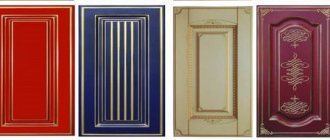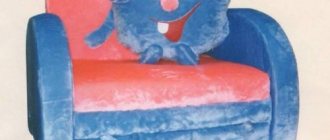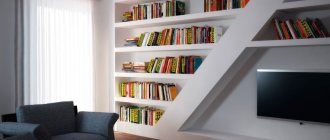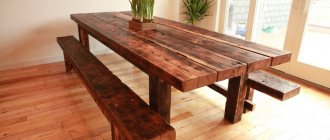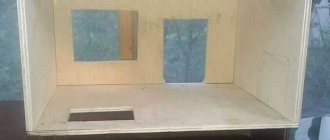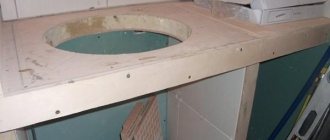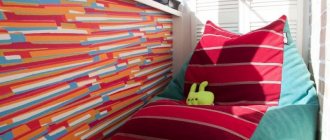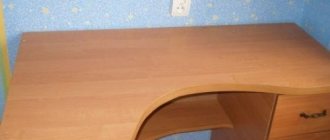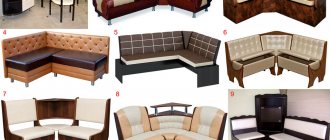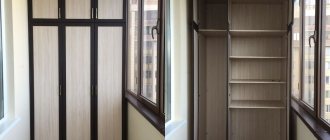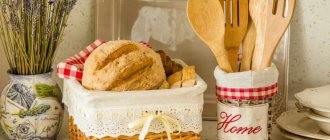With this information, you will be able to organize large and small chipboard production, but not at home, because... the line is very cumbersome. Here you will learn about the equipment for making chipboards (line, machine), its price, as well as about the technology and video of the entire process.
Chipboard is an environmentally friendly, easy to process, practical material, a high-tech alternative to solid wood, successfully used for cladding walls and roofs, making wall panels, making flooring for carpets and linoleum coverings, flooring, various partitions, producing removable formwork, making shelves, furniture , packaging, construction of fencing and collapsible structures, decoration and finishing of premises.
How to make a liquid tree with your own hands
Although they say that liquid wood is a new modern material, it was used back in Soviet times.
Only it was not sawdust that was used, but wood dust - putty was made from it and holes, cracks, and chips in various wooden products were sealed.
Nowadays, liquid wood is made from sawdust, wood chips and shavings.
At home, to prepare “liquid wood” material for crafts, it is easier to take sawdust and PVA glue.
The mass is mixed, left for about ten minutes and can be tinkered with or poured into a mold.
True, PVA glue has several disadvantages:
- it is not transparent, so it is not suitable for everything - in jars it is too thick and you have to stir it with water.
I. Advantages of PVA:
- after hardening, the manufactured products are very durable - both in liquid and frozen states it is completely safe, because does not emit any toxic substances - burns very poorly
Epoxy gives transparency and beautiful color to products using the “liquid wood” technique.
The downside is
that you can only work with it in a well-ventilated area, since the resin is toxic.
Polyester resin
is less toxic, but just like epoxy, it shrinks strongly when it hardens and this should be taken into account when making any crafts.
So, everything is clear with “kneading” liquid wood. Let's move on to the forms.
You can use silicone molds to make boards, parquet slabs, figurines, and sculptures. (This, of course, is not all of the things listed that can be done) If we make it from a mixture of sawdust, shavings and epoxy, then the mixture must be heated from 40 to 60 degrees and quickly poured into the mold.
The mixture in a liquid state will “live” for up to 20 minutes, then the hardening process will begin.
Next, you need to correctly remove the finished product from the mold:
- silicone mold, bend it at the edges, turn it over and start removing it, carefully holding the finished mold. - rigid form, also turn it over and lightly tap the entire bottom with your fingers so that the vibration causes the product to move away from the mold.
The latter is processing with a file or sandpaper.
Using sandpaper and a file, we remove defects or irregularities.
By the way, before pouring the “liquid wood” into the molds, make a small portion of the mixture, about 100 ml. This will determine not only the correct proportions, but also the strength and appearance of the finished product.
Liquid wood is an ideal material for repairing various surfaces made of chipboard, MFD, chipboard and wood of any species.
In their practice, “liquid wood” was used to repair pine cuts.
Improper drying led to several cuts being torn. I had to, and it turned out to be a good idea, to seal the holes with liquid wood - a mixture of small sawdust and PVA, then simply sand the patches. And no one noticed!
Afterwards we repaired the countertop - it turned out great.
After the liquid wood patches had dried, they covered everything with varnish. True, before this we again went through a little sandpaper and colored it to match the main color of the tabletop.
Source
How to make chipboard at home?
We must immediately define the concept of “home conditions”.
This formulation also includes a “corner” in the kitchen and a mansion with a plot of several hectares.
If it is possible to locate a workshop for the production of chipboards in the local area, then, in principle, production is possible in such “home conditions”.
If you mean an apartment, or a small house, then there are no options at all, because the production of chipboard is a method of “hot” pressing of chips (wood) with the addition of resin.
That is, in addition to everything, you need press-to-press mixers with dispensers, forming machines, coolers, automatic cutting machines for finished sheets, drying drums, grinding machines, wood waste crushers, and so on.
The equipment is different, but in general it is dimensional equipment
There is no way to make chipboard “on the knee” (we read, ordinary home conditions, or even garage conditions), it is not technologically possible.
There is no way for this process, other than the components that are, in principle, available, you also need to have an industrial high-temperature press, which simply will not fit into the house))
Chipboard is wood chipboards that are produced in special factories. To make chipboard at home, you need to create a workshop or a small enterprise for the production of chipboard, because making chipboard involves mixing sawdust with an adhesive material, such as an agent, then this must be pressed at high pressure and high temperature.
To make chipboard, you need mixers, thanks to which a homogeneous mass is obtained from sawdust, as well as from an adhesive material.
Also, you need a special apparatus to give the sawdust and adhesive material the desired shape, the next step is to press the sawdust, for this you need a press with hot air. After the press, the chipboard needs to be cooled; a special machine is needed for cooling, after which the future chipboard is cut and sanded, quality checked, laminated, and only then prepared for sale or used for making furniture.
To make chipboard, you need not only special equipment, you also need to know how to make chipboard correctly, and you also need a license for its production and a certificate.
If you decide to make it at home, then for this you need to at least have a small room, a press, you need to mix sawdust in small containers, 15-20 liter containers would be an excellent option, then you need to add a binder to the sawdust to give the desired form, a press is used to obtain the desired shapes, the next step is to cool the product and cut it.
Once the product has cooled, a laminated film can be applied to it.
To make wood at home, you need to spend a lot of money to buy special equipment.
Source
Manufacturing stages
At first, it is not always clear to a beginner what to tackle first. You can find a simple master class in open sources, but in many videos and instructions they rarely pay attention to dividing the work into stages. But a detailed description is very important, as it helps to do everything consistently, quickly, and at the same time with high quality.
Features of the use of furniture polishes, popular brands
Drawing
A prerequisite for starting work is to find or complete a furniture drawing. It is compiled manually or using special programs on a computer. You can also find ready-made drawings in forums for craftsmen. You need to have at least the slightest skills in reading diagrams if they are taken from a third-party source. Drawings are not always correct; they need to be checked. If you don’t have such a skill, then you should consult with a knowledgeable person.
Detailing
This is called drawing up a diagram of individual parts of a product. This approach will allow you to divide the assembly process into stages. Also, from a solid drawing it is not always possible to determine the exact dimensions of the constituent elements. Having initially spent more time at this stage, it will then be much easier to assemble the furniture and make individual parts for it.
Cutting, processing of slices
When you have an idea in your head of what needs to be done, and how to get it is reflected on paper, cutting the material into sheets of the required size begins. It’s worth making as many of them as you need at once, and cutting out individual elements from each piece. It will work faster and easier this way.
After cutting, it is necessary to process the cuts. Even the best quality tool will leave nicks in the material. Sandpaper or felt cloth is used for processing.
Drilling holes for fasteners
Already on the finished parts, using a drill and a drill or a screwdriver, all the holes are made. This stage should not be taken lightly. Chipboards are very sensitive to such procedures, so you need to be careful. It is necessary to know the exact diameter of the holes in advance. You will not be able to change them in the future.
Assembly
Only after all the stages comes the furniture assembly itself. There is nothing complicated here anymore if the master thought through the drawings in advance and chose the right fasteners. The only thing you need to be careful with is the sensitivity of the material to drilling, screwing and any deformation. Too much force may strip the threads. It will not be possible to re-screw the screw into this hole; you will have to make a new one.
Finishing
The final stage is finishing and decoration. The varnish coating is responsible for how long the furniture will last. A good product will protect against deformation and moisture. You can also use a special film instead. If you plan to paint furniture, then it is done before applying a protective layer and with preliminary treatment - sanding, cleaning, leveling the surface. There is no need to think about how veneer cladding is done at home. This is a complex procedure that can only be performed in a factory.
Master classes on making transformable furniture with your own hands at home
Production of chipboards (chipboards)
Chipboard (chipboard) is a currently popular building material. This success is facilitated by the appearance of the sheets, some characteristics improved in comparison with wood, as well as their relative cheapness. Among the improved chipboard parameters, the following stand out:
- resistance to wood insect pests;
- higher resistance to cracks and various defects;
- easier sheet processing;
- higher fire resistance
- availability of sheets: compared to wood, it is cheaper.
It is these characteristics that have made chipboard sheets one of the most used materials in various fields. In addition, the production of chipboard, although labor-intensive, is very profitable and profitable, because it can pay for itself in an average of 1-1.5 years.
Business combination
Due to the oversaturation of the building materials market, significant efforts have to be made to attract attention to their products. There are several methods for this kind of action. One of the simplest is to expand the offered range as much as possible.
This can be achieved by incorporating a particle board finishing step into your production process.
There are the following types of cladding:
- lamination (processing of a paper-resin coating under high temperature during the production process in special lamination equipment);
- laminating (using the same coating, but using different equipment and technology - using an adhesive composition on ready-made slabs);
- cladding with laminated plastic - polymer containing reinforcing and decorative fillers;
- facing with natural veneer followed by varnish coating.
Having applied these technologies, direct an advertising campaign to the possibility of using manufactured products in any area, focusing on additional services. In this case, there will be a much greater chance of attracting the buyer's attention to your product.
Video on the topic:
Lamination process
Laminating
Veneering
Download for free a short business plan for the production of chipboards (.rar file):
Example 1
What it is?
Chipboard is a sheet composite material produced by pressing sawdust and shavings at high temperatures with a non-mineral binder and the introduction of various additives, which are necessary in various cases to improve certain properties of the resulting sheet. The production of this material is quite expensive, but at current prices for the finished product, the purchased equipment pays for itself in 1-2 years.
Depending on different indicators, there are several classifications of chipboard. Some classifications are given below.
Main types
The CIS GOST documentation identifies the following characteristics for classification:
- Based on the number of layers, chipboard is divided into single-layer, two-layer, three-layer and multi-layer. Moreover, the trend is this: the greater the number of layers, the more dense and durable the resulting slab.
- By emission class. Emission determines the amount of formaldehyde that, when added during production, is released into the air from 100 g of slab. There are 2 classes: E1 and E2, while the first is more environmentally friendly, harmless to people, the content of harmful substances in it is less than 10 mg. Another class contains more than 10 mg of formaldehyde. Boards of this class are suitable for use in construction and production with good ventilation or outdoors. There is also a certificate for chipboard that confirms its emission class. The certificate is issued by a special body, has an established model and is distributed throughout the CIS. The current standards for assessing the toxicity of formaldehyde in Europe differ from those adopted in the CIS countries.
- Based on the density of chipboard, slabs are distinguished with low density (550 kg/m³), with medium density - 550–750 kg/m³, with high density - more than 750 kg/m³.
Technology selection
At the initial stage of production planning, you should decide on the type of production process.
In this case, two options for chipboard manufacturing technology are possible:
- using ready-made raw materials;
- use of own raw materials.
If we keep in mind a simpler technology (finished raw materials), then we can distinguish the following stages of the technological process:
- The finished raw material (process chips) is mixed with glue (which is a thermosetting resin with standard additives) for thickening.
- The resulting mixture of ingredients is distributed into form-building containers of various sizes.
- The mass is pressed under high pressure and temperature until a homogeneous and durable slab material is obtained.
- The slabs are trimmed and cut in accordance with the order.
- You can include the stage of additional processing of chipboard - grinding, coating with polymer materials, lamination, etc.
If you plan to launch a line that includes your own production of raw materials, then the following stages will be added to the production process:
- Delivery of wood production waste.
- Primary processing and sorting of the initial mass.
- Processing of mass by chipping and flaring machines to obtain technological chips.
Video on the topic:
Technology
What is chipboard made from?
To make chipboard, three components are needed: wood chips, a binder (most often resin or formaldehyde derivatives) and additives to obtain new properties.
Raw materials
The raw materials are various waste from wood processing, logging and sawmills. These include the following types:
- low quality round lumber;
- branch;
- cuttings;
- shavings;
- sawdust;
- low quality wood slabs or slabs;
- low-quality butt part of wood or bottom part;
- whip trimmings.
The importance and significance of making slabs becomes clear. From waste and low-quality timber, material is obtained that is suitable for the production of durable and high-quality products, and chip and sawdust processing increases the yield of wood processing by up to 90%.
Binder
In order for wood waste to stick together, a binder must be added to the mixture of raw materials. For the first prototype chipboard sheet, they used casein glue in 1887. And only 46 years later they came to use resins instead of glue as a binder. The first resins that began to be used in production were phenolic and urea. For the production of chipboards intended for external cladding, urea-formaldehyde resins modified with melanin are used as a binder. At the same time, their weather resistance will be low. To obtain chipboard with high weather resistance, phenolic resins or diisocyanates were added to wood raw materials.
In addition to them, resins such as phenol-cresol and xylenol-formaldehyde were also common. As a result, to speed up the hardening process, they began to add more concentrated derivatives of formaldehyde and sodium hydroxide to react with it. When caustic soda reacts with formaldehyde derivatives, an alkali is obtained and formaldehyde gas is released into the atmosphere. Therefore, they are not suitable for use in the production of chipboards for furniture and interior decoration. To reduce toxicity and emissions into the atmosphere, phenol and xylenol have been abandoned, and resins with a smaller volume of alkali formed, or without it at all, are being used. Currently, there are environmentally friendly resins that emit no more than 0.5 mg of formaldehyde per 100 g of slab into the atmosphere. Low-toxic mixtures are also used, which pose virtually no harm to the environment or health.
Special Additives
They are used only to add special characteristics to chipboard sheets. Often the volume of such additives is about 6–10% of the mass of wood particles.
Characteristics that can be obtained during the production of chipboard: fire resistance, hydrophobicity, increased strength. Additives that allow you to achieve the listed characteristics are fire retardant, water repellent, antiseptic.
Types of chipboards and areas of application
The range of application of this material is incredibly wide. It is used for the production of inexpensive furniture, in interior decoration, and even in the musical instrument industry.
The tiles are made from wood chips and are used for so-called “substandard” wood – that is, wood that does not have a decent appearance or has other shortcomings, as well as forestry waste.
Chipboard is a cheap and lightweight material, environmentally friendly and very easy to manufacture. For these qualities, many novice entrepreneurs pay attention to it and engage in its production - often with great success.
Chipboards are distinguished by grade. There are 3 types of tiles:
- First grade. High-quality workmanship that meets high standards of finishing materials. The structure is smooth and durable.
- Second grade. Chipboard with minor defects - scratches, chips. It differs little from the first one, but costs less.
- Ungraded chipboard. Produced from low quality shavings with many flaws. Despite this, it is very often used in construction, where appearance is not so important, or for interior decoration.
In addition, tiles vary in cleanliness. There are 3 cleanliness classes:
- E1. Low content of harmful resins - up to 10 mg per 100 g.
- E2. The average level of resin content is up to 30 mg.
- E3. High contamination with formaldehyde – up to 30-60 mg.
Of course, tiles with cleanliness class E1 are considered the cleanest and safest. You can distinguish them using your sense of smell - chipboard contaminated with resins smells strongly of chemicals.
Watch the features of chipboard production in this video:
And the very last thing: in addition to simple ones, there is laminated chipboard. Laminated means covered with a special film that protects the tiles from damage. It is much more difficult to produce than usual, but is sold at a much higher price.
Chipboard production
The technology for producing wood boards consists of mixing wood raw materials with an adhesive agent and pressing under high pressure and temperature. The production cycle helps turn substandard viscous mixture into a finished product.
Equipment
The technological cycle of chipboard manufacturing is based on the use of simple and high-performance equipment, which is a single complex. The use of high technology on production lines is not mandatory, although setting up and maintaining the continuous production state of all machines on the line is a difficult task that cannot be solved in a standard way.
The chipboard production line includes:
- mixers - necessary to achieve uniformity of raw materials when mixing sawdust and a binder (a resin composite with a thermohardener, to which special substances can be added that give special characteristics to the slabs);
- devices for shaping - they form a viscous mixture of wood raw materials with a binder in portions for the production of boards;
- devices for pressing at high temperatures - necessary to ensure that the formed chipboard blank hardens under high pressure and temperature;
- cooling devices – responsible for accelerating the cooling of compressed sheets;
- devices for cutting edges - for removing the ends of slabs;
- grinding machines – give smoothness to the formed top layer of slabs.
In this case, the devices operate automatically, and quality management and support of system settings at a given technological level occur simultaneously.
Manufacturing technology
The chipboard production technology is a rather labor-intensive process, but with proper automation it does not require much attention and control from people.
First, the raw materials are processed. It includes such stages as: receiving or unloading chips; sorting chips by size; and purification from impurities. As part of the first stage, the wood is analyzed for its fraction: if it is small, then it is transferred further; otherwise it is crushed, after which it moves on. The second stage is sorting the chips by size. This is where the separators are divided into small and large parts and placed in different containers. For the surface layer, small shavings and sawdust are used, as well as grinding dust. Moreover, the inner layer contains these components up to 20% of the total mass. After purification from impurities, the resulting mixture moves to the second stage.
The second stage of the cycle is drying the resulting mixture. In this case, chips of different layers are dried separately in order to comply with humidity standards. Thus, the moisture content of the final mixture for the inner layer should be in the range of 2-4%, and for the remaining layers - 4-6%. In the production of slabs, convection drying is usually used.
After the chips have dried, stage 3 begins, during which the chips are coated with a binder or mixture. It is important that each individual chip is coated with the mixture to better bind into a single layer. In this case, it is also necessary to calculate the correct % of binder to avoid overuse. Both of these characteristics affect the quality of the final slab.
Forming the resulting viscous mass into a wood board shape. Molding devices are responsible for this, which precisely divide the carpet of the viscous mixture into portions, from which chipboard sheets will then be made. The main thing here is that the mixture is distributed evenly both in length and thickness, otherwise the quality of the slab will be lower.
Next, the portion follows to the press. There it is compressed at a pressure of 30-40 kg/cm2 and a temperature of 180–220 °C. At the same time, 2 types of units are common: extrusion and flat. As a result of pressing, an almost finished sheet of chipboard is obtained, but still hot.
What you need to start
The first step is registering a business. For small businesses, two forms are best suited: individual entrepreneur and LLC. The first is characterized by low duties and ease of opening, but it is more often used in the field of trade and entertainment. For medium-sized production, the LLC form is best suited.
The company is registered with the Federal Tax Service (Federal Tax Service). For an individual entrepreneur, you only need a copy of your passport, an application and a state fee. An LLC requires a more serious set of documents - minutes of the meeting, charter of the company, etc.
Launching a workshop is the most important and difficult barrier, behind which everything becomes easier. The most important thing is equipment. The right choice of tools will not only make it easier to get started, but will also save thousands and thousands of rubles.
So, what equipment is needed to start chipboard production (taking into account that production will be from scratch, that is, without ready-made raw materials):
- Chipper;
- Planing machine;
- Dryer;
- Mixer – mixes shavings and glue;
- Heat press;
- Finishing machines (for trimming excess parts, grinding).
The equipment is quite serious, and it is unlikely that you will be able to set up your own workshop at home or in a garage, even if you purchase ready-made raw materials.
Chipboard production scheme.
Therefore, you also need to worry about finding premises. Its size may unpleasantly surprise those who were expecting a room measuring 20-30 square meters. A complete chipboard production line from start to finish requires several workshops and at least 300 square meters of area.
The next question is personnel. Workers will be needed in any case, and at least 4 people. As for working with papers, you don’t have to hire a full-time accounting department and a secretary - a “coming” accountant or the services of an accounting office, which will cost much less, will be enough.
How to independently maintain personnel records - details here.
Costs and profits
Unfortunately, chipboard production is not a business that you can enter with a minimum of money. Opening a small plant for the production of particle board tiles will require at least 15,000,000 rubles.
Here's what this money includes:
- Production line – about 10,000,000 rubles;
- Raw materials – 4,000,000 rubles;
- Rent of premises and wages - about 300,000 rubles;
- Other expenses (marketing, additional equipment, starting a business) – up to 1,000,000 rubles.
If you need to spend money on production machines once, then the purchase of raw materials will have to be made monthly.
And although such a plant requires large investments, monthly revenue will be no less than 6,000,000 rubles, that is, the net profit will be almost two million. It follows from this that with proper management of the enterprise, it will pay off in less than a year.
Chipboard production process
The process consists of several stages:
- Mixing glue and shavings in a special mixer with the addition of additional components. The composition is selected individually, taking into account the requirements for the finished product.
- The finished mixture is sent into molds.
- Placement in press for pressing.
- Cutting the sheet to the required size on a machine.
- Grinding. The last and very important stage in material processing. The quality of grinding largely determines what grade you will get at the end.
After all stages have been completed, the finished products are sent to warehouses and await sale.
What is a chipboard production line like, watch the video:
Sales of finished tiles
The finished products are used by both construction organizations and individuals who independently repair or build a house.
Second-grade and ungraded slabs can be sold immediately after production, since they usually do not undergo additional processing.
It's a different matter when it comes to first-grade chipboard. It is much more profitable to laminate finished products, that is, to make chipboard.
Despite the additional costs, the benefits of such an enterprise are obvious - chipboard is much more expensive than simple tiles.
There should be no difficulties in selling quality products. The country is experiencing a construction “boom”, that is, huge spaces are being occupied by suburbs. Sometimes these suburbs are larger than the city itself. Naturally, the demand for construction products is very high.
In addition, you can organize related production and expand the range of products.
As for advertising issues, in this case you need to both advertise in various media and independently promote the finished product, offering it to organizations that are engaged in construction or retail sales of building materials.
If you are a new entrepreneur, then these tips are for you.
Tips for expanding your business
Such a large plant should not stand idle. It is possible that the demand for chipboard will not be constant, and additional sources of income will have to be looked for.
Fortunately, you can add additional equipment to your workshop and produce:
- Other materials (chipboard, fiberboard, MDF);
- Furniture (inexpensive furniture made from chipboard, such as cabinets or chests of drawers, are very popular).
You can offer raw materials to enterprises producing the same tiles that do not have the opportunity to produce it themselves.
Chipboard production in 2021. Photo: eo.ru
What can be made from sawdust: extracting benefits and benefits from wood waste
In the article we will talk about various ways to get rid of sawdust , their use and compare them with each other.
In some cases , you have to pay for someone to remove and dispose of sawdust in one way or another, in others it is taken by interested individuals or organizations, and it happens that a profitable business is created by processing this material.
How can you use sawdust?
Sawdust is a unique material that has many of the properties of wood . Therefore, such material is in great demand in:
- fuel production;
- production of building materials;
- home and agriculture;
- repair and construction work.
Fuel production
Various types of fuel are obtained from sawdust, among which the most famous are pellets and briquettes .
These types of fuel can be used for conventional boilers, stoves or fireplaces, but the maximum effect is achieved only in automatic heating devices .
After all, all elements of one batch are identical in size and shape, thanks to which automatic fuel supply systems can dose them more accurately. Read more about these types of fuel here.
Another popular type of fuel is a mixture of various alcohols , which is obtained from fermented sawdust.
This material is mixed with a sulfuric acid solution and heated under pressure, causing the cellulose to break down into simple sugars that can be fermented.
After fermentation is complete, the mass is passed through a distiller, resulting in alcohols of various qualities .
Read more about this use of sawdust in a separate article.
pyrolysis gas is obtained from sawdust , suitable for use in heating and kitchen stoves, as well as in hot water boilers and other natural gas-powered equipment.
In terms of calorific value, pyrolysis gas is much inferior to natural gas, but, due to the minimal cost of its production, heating with pyrolysis gas is often cheaper than with natural gas.
Read more about this gas, the method of its production and use here.
Manufacturing of building materials
Sawdust is used to produce building materials such as sawdust concrete.
Compared to ordinary concrete, this material is noticeably lighter, and also has lower thermal conductivity , so a house built from it loses less heat, which means you will have to spend less on additional insulation.
In addition, wood in concrete improves the vapor permeability of walls , due to which such houses always have optimal humidity, because its excess goes through the walls to the street.
You can read more about this material here.
Another popular material made from sawdust is wood concrete. In many ways it is similar to sawdust concrete, but it also has differences. After all, the mixture for pouring wood concrete is prepared without adding sand, that is, by mixing cement, sawdust and water.
In addition, this material is lighter and stronger than sawdust concrete, although it is much more expensive. You can read in more detail about the production and use of wood concrete in this article.
insulation and finishing materials are made from sawdust :
- Fiberboard (fibreboard);
- Chipboard (chipboard);
- organic insulation.
Fiberboard is used for finishing walls, ceilings and floors, as well as for lining the interior of cabinets.
On the basis of fiberboard, a popular finishing material is made - hardboard, which differs from fiberboard by the presence of a decoratively treated side. Chipboard is used to create furniture and many other works.
Organic insulation is only slightly inferior to mineral wool, but environmentally friendly , because its basis is paper obtained from sawdust.
Household and Agriculture
Sawdust is an excellent material for feeding various animals . This applies to both pets, such as hamsters, parrots or cats, and various livestock.
The material for backfill is chosen based on many factors, one of which is smell, because fresh sawdust has a strong smell, and not everyone likes it.
For more information on how to choose bedding, read the article (Sawdust for pets).
Another use for this material is mulching the ground around plants.
Bare soil quickly loses moisture, overheats and cools, causing plant roots to suffer. By filling the soil around the plant with waste from sawing wood, you will protect the roots, which will make the plant better able to withstand winter cold and summer heat, and it will also be possible to water it less often.
Wood sawing waste is an excellent material for growing mushrooms and creating high-quality fertilizer . Mushrooms receive enough nutrition from them to multiply quickly, and the cost of such food is low, and you can often get it for free.
Sawdust also produces good humus , which saturates the soil with nutrients and increases plant productivity.
To learn more about this method of using wood sawing waste, read the article (Fertilizer from sawdust) . It is also very convenient to cover paths between beds in fields, vegetable gardens or greenhouses with sawmill waste.
Even after heavy rains, you can walk along such paths without getting smeared with mud , so you can check the plants after a rainstorm.
Once every few years you will need to plow the garden or field so that the sawdust is evenly distributed over the ground and fertilizes it.
Repair and construction work
The main use of sawdust during repair and construction work is various insulation .
They are poured between thin wooden walls, due to which, at minimal cost, the thermal conductivity of such a wall is comparable to the same parameter of a wall made of timber of the same width.
That is, with a wall width of 20–30 cm, insulation will be required only in the northern regions.
In addition, wood sawing waste is mixed with clay and the resulting solution is used to insulate ceilings, floors and brick walls.
The effectiveness of such insulation is much lower than that achieved by using mineral wool or polystyrene foam , but the thickness of the layer can be increased, which results in significant savings.
The same compositions are made on the basis of lime or cement, which act as a binder. Read more about all the methods of insulation using wood sawing waste here (Insulation with sawdust).
Processing business
If there is a constant supply of sawdust or the ability to get it for free or very cheap, then you can start a business processing it. The final product can be anything, so it is necessary to focus on the demand for a particular product.
For example, if there is a bad gas supply in the region, but people have the opportunity to buy automatic boilers , then high-quality pellets and briquettes will be in good demand. Read about choosing such a boiler or burner here.
In those regions where the construction sector is actively developing, the production of blocks from wood concrete or sawdust concrete can be profitable.
After all, access to free or very cheap sawdust allows you to produce products whose price will be lower than the market average for similar products.
If you are interested in such a business, then read more about it here.
Another promising direction is the production of sawdust for cats or hamsters.
To do this, wood sawing waste is dried, treated with deodorants , which impart a pleasant smell to the material, and packaged in paper or plastic bags.
No less interesting can be the sale of sawdust in bags for smoking.
After all, each product uses its own combination of wood species , which provides the best taste and smell, so packaged sawdust of various types of wood will be in demand.
Responsibility for disposal of waste from the wood processing industry
Despite the fact that sawdust is classified as hazard class 5 according to the federal catalog of waste classification, that is, practically safe, it still needs to be disposed of in any available way.
In addition, dried sawdust is a very fire hazardous material , which is difficult to extinguish if the fire has gained strength. Therefore, wood sawing waste can be disposed of in any available way:
- dispose of in a landfill;
- bury in the ground;
- distribute to people and businesses;
- sell to any buyers;
- use for heating in winter;
- use in a subsidiary farm for any needs;
- used to produce pyrolysis gas and use it in any way;
- hand over to the nearest pulp and paper or chemical plant that processes wood;
- process in any way (a license may be required for the production of some products).
If sawdust is not removed for a long time and there is a threat of fire or someone else’s territory becomes cluttered , then questions may arise from various regulatory organizations.
In Russia, the disposal of any waste, including sawdust, is regulated by Federal Law No. 89-FZ of June 24, 1998 “On Production and Consumption Waste,” which you can read by following this link.
Another document regulating the disposal of any waste, including sawdust, is the federal law of March 30, 1999 N 52-FZ “On the sanitary and epidemiological welfare of the population.”
In it, all issues of waste storage and disposal are considered in terms of the impact on the sanitary and epidemiological well-being of people.
Therefore, any disposal method must comply with the laws adopted in Russia.
For one-time burning of small amounts of sawdust no permits are required, but for regular burning of large volumes, not only permits for the combustion itself are required, but also a solution for the disposal of the final product - ash or soot.
The same applies to burying sawdust in the ground. In some regions, claims may be made by officials in connection with formal violations of some points of the law, but in reality, lobbying for the interests of landfill owners .
Cutting tools and equipment
Depending on the volume of work to be done and the configuration of the cut, use:
- electric jigsaw;
- circular saw (parquet);
- manual frezer;
- hacksaw;
- professional equipment.
Not every tool can produce parts of the required shape.
Slitting machine
Cutting chipboard on a format-cutting machine
If you know the exact dimensions to which the sheet should be cut, it is better to entrust the work to professionals. Almost all sellers - bases and construction markets - provide this option. Often the cutting service is free, the customer only pays the cost of the chipboard.
For cutting, format-cutting machines of various designs are used.
additional devices allow you to saw off chipboard without chipping For example, on some models two sawing discs are installed: the first, of small diameter, cuts through the surface laminated layer, and the main one makes a full cut.
CNC cutting machines operate in a semi-automatic mode, eliminating operator errors, which allows you to obtain finished parts with dimensions accurate to 1 mm. This is important in the manufacture of cabinet furniture.
Jigsaw
You can use a jigsaw to perform shaped cutting.
An electric jigsaw can be used to cut a sheet along straight and shaped lines .
Advantages of the method:
- accessibility - most craftsmen have a jigsaw, and a new one is inexpensive;
- There are special files for sale for chipboard, chipboard and laminate;
- You can cut circles with a small radius;
- Suitable for making through holes for hatches or electrical installations.
To obtain a straight cut, you need to have experience working with the tool or just use a guide bar.
Parquet
A hand-held circular saw , sometimes called a “parquet saw,” is used if there is a large amount of work on cutting chipboard along straight lines .
Purchase discs with carbide tooth tips.
To simplify and speed up the work, choose parquet flooring complete with a guide rail or purchase an additional accessory separately.
Hand-held circular saw with a guide bar
You can do without additional parts if you cut along a guide from a corner or plaster rule.
The main disadvantage of this method is the inability to make a curved cut.
Fraser
To cut chipboard efficiently using a router, the craftsman needs a lot of experience.
A smooth, flawless edge is obtained only when using diamond cutters , the price of which is high.
Valera
The voice of the construction guru
Ask a Question
At home, a router is often used to finish the edges of laminated chipboard. In these cases, the sheet is cut with a hacksaw, jigsaw or circular saw, and then the cut is processed with a router. It is important to provide a margin of 1.5–2 mm, which will be removed with a cutter.
Hacksaw
To cut chipboard you need a hacksaw with fine teeth.
Cutting with hand hacksaws takes a lot of time and requires a lot of physical effort .
Hand saws with large and medium teeth are only suitable for sawing regular chipboard (without laminated layer). The result will always be accompanied by chips and scuffs. The appearance of the edge can only be corrected with decorative overlays.
A small amount of cutting is performed with a hacksaw with fine teeth. To reduce the number of chips , stick masking tape over the sheet, mark the cutting line and only then start working.
Question to the expert
What should you not cut chipboard with?
Despite the fact that the seats of saw blades for parquet flooring and an angle grinder may coincide, cutting chipboard and wood with a grinder is strictly prohibited. The torque of even a weak machine will tear the tool out of your hands, and the disc will cause injury. The danger is that the rotation cannot be stopped instantly.
Advantages and disadvantages of various processing methods
Any owner of a woodworking enterprise or sawmill wants to get rid of sawdust with maximum profit, but there are situations when it is no longer a question of profit, but of minimizing the costs of disposing of this waste.
Processing is the most profitable, but it all comes down to the complexity of selling the finished product and the high cost of equipment .
To transport sawdust to a landfill, you need to obtain permission from Rosprirodnadzor (RPN) and buy quotas, and these are all considerable expenses.
After all, the amount of payment depends on the volume of material transported to the landfill. It is possible to bury sawdust in the ground if we are talking about a small batch, but when tens or hundreds of cubic meters of waste are received monthly, it is no longer possible to bury it .
In addition, there is a high probability that burying large volumes of sawdust in the ground will arouse the interest of RPN officials, who will immediately begin issuing fines, because such work must be coordinated with them.
Wood sawing waste can be distributed to people free of charge , but in this case it is necessary to conclude an agreement with them on the free transfer of material assets.
Otherwise, questions may arise from the tax office.
Such an agreement can be concluded in simple written form.
Wood sawing waste can be sold in any volume if there are buyers, but you also need to enter into an official agreement with them and issue a receipt , otherwise questions will arise from the tax office. The same situation applies to the delivery of waste to recycling plants.
in bags with delivery may be very popular , even if you don’t make money from it, you can get rid of some of the accumulated waste. Stores take this product for sale at a low price and sell it as cat litter.
For such a sale, you will also need to enter into an agreement with the store , as well as attach receipts confirming payment for the goods by the store. The disadvantage of this method is high transportation costs and the inability to accommodate large volumes of material. After all, even hypermarket chains will be able to take only a few tens of cubic meters of such material per month.
The easiest way is to use sawdust to heat your own premises in winter - no documents are required for this method of disposal.
However, even in this case, bureaucracy cannot be avoided, because during the combustion of wood, soot and ash are formed , which also need to be disposed of somehow. Otherwise, questions arise for the RPN and the fire department. After all, according to their logic, soot and ash are simply thrown into a landfill without paying a disposal fee for it.
In addition, in the event of a fire at a landfill or any nearby waste storage site, but refuse to enter into an agreement for their disposal will be under suspicion
The situation is the same with the production of pyrolysis gas: permits for the process itself and the use of gas on the territory of the enterprise are not required, but you still need to conclude an agreement for the disposal of soot and coal .
There are situations when sawdust sits for a long time and begins to rot, as a result of which cellulose breaks down into carbon dioxide and various sugars.
It is difficult to get rid of such sawdust, because no one wants to take it even for free, so the easiest way is to bury it in the ground, having received permission from the RPN . This will cost less than purchasing quotas required for disposal of solid household waste to a landfill.
If the nearest RPN office is several hundred kilometers away, then sawdust can be buried without their consent.
We have prepared links to forums where various methods of sawdust disposal are discussed:
